As the Bordeaux en primeur campaign continues, Wine Lister examines the best-quality wines from a challenging vintage (read our vintage report here).
Wine Lister’s partner critics’ scores are now all in, and with one new addition for the 2021 en primeur campaign: Le Figaro’s scores have been added to those of Wine Lister’s existing critics (Antonio Galloni and Neal Martin from Vinous, Jancis Robinson, Bettane+Desseauve, and Jeannie Cho-Lee) to create the overarching Wine Lister 100-point score. The top 29 wines of the vintage are shown below.
From a year acknowledged as the most complicated vintage since 2013, 29 wines achieve WL scores of 95 and over, compared to 43 last year. Wine Lister’s 100-point score combines normalised scores from Wine Lister’s partner critics. For the first time this year, the score also includes ratings from Wine Lister’s parent affiliate, Le Figaro Vin.
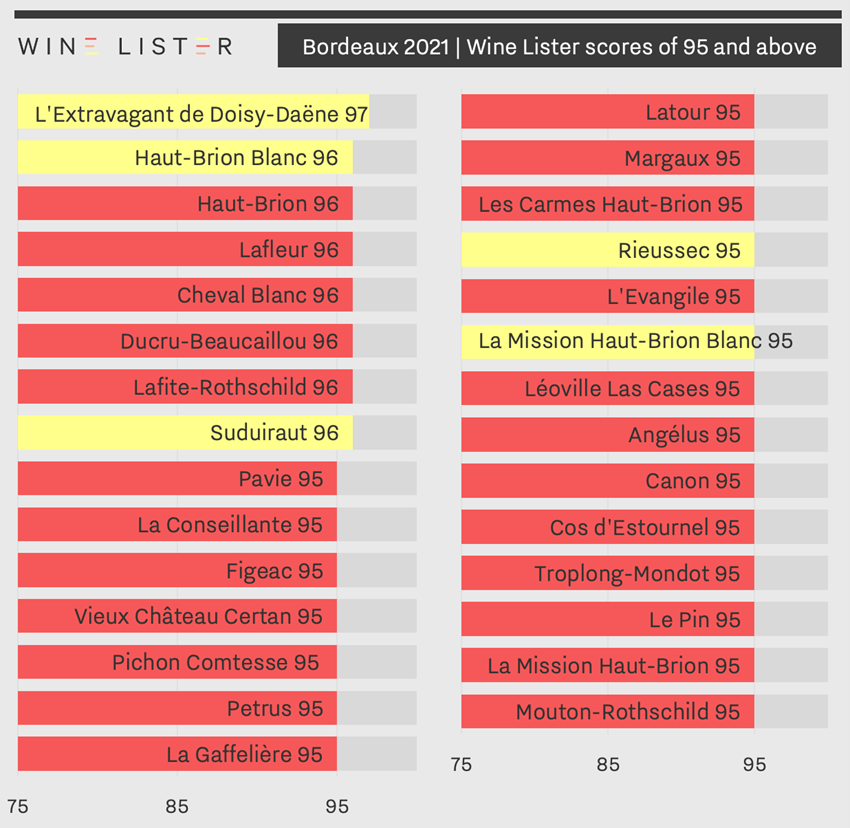
Bordeaux 2021 – Wine Lister scores of 95 and above
In 2021, the top- scoring wine is L’Extravagant de Doisy-Daëne from the Sauternes appellation with a score of 97 points – one point up on its score in 2020 . Two other sweet wines make the top cut – Suduiraut and Rieussec – in a year that has produced beautiful Sauternes and Barsac wines, if very little of them. Indeed, wines from sweet appellations in 2021 show quality overall that is unsurpassed since the 2015 vintage.
These are joined by two dry whites – Haut-Brion Blanc and La Mission Haut-Brion Blanc, earning 96 and 95 points respectively. Haut-Brion’s red counterpart and Lafite take an equal lead over fellow first growths, Latour, Margaux, and Mouton in 2021.
Also equalling the impressive score of 96 is super-second, Ducru-Beaucaillou, and left bank darlings, Cheval Blanc and Lafleur (both already released – see our latest release blog for details).
Of the 19 reds earning a score of 95, 11 (or 58%) hail from Saint-Emilion and Pomerol collectively. This is perhaps surprising, given that the vintage is reported as having been more difficult for Merlot than Cabernet Sauvignon. With fewer top-scoring wines than last year, the 2021 vintage is all about terroir and resources, with first growths and renowned right bank stars dominating the list.
However, even top scores are lower than in 2020. In 2020, the highest scoring wine was Chateau Margaux with a Wine Lister score of 98, 10 wines scored 97 points and 14 wines scored 96 points (compared to just one 97-pointer in 2021, six 96-point wines and 22 95-point wines).
That’s an average top 29 score of 96.3 in 2020 compared with 95.3 in 2021. That the difference is only one point in the context of such a difficult vintage is surely a reflection of excellent wine making across the region.
Most of the ranking movements are therefore relative, reflecting the fact that scoring 96-97 points in the 2020 vintage was more widespread that in 2021. For example, Suduiraut gains 31 places in 2021 despite also achieving a 96-point rating in 2020. Similarly, Troplong-Mondot and Le Pin are also risers despite their scores remaining unchanged compared to 2020.
One particular success among this is La Gaffelière, which ranks 15th in 2021 with a score of 95, a three point increase on its 2020 score of 92.
A feast fit for a Queen
Emmanuel Cruse and the Château d’Issan team were this month (17th May 2022) joined by 70 leading figures from the UK’s fine wine trade for an evening of celebration at historic Royal landmark, Kensington Palace. Organised by WLPR, the event commemorated the 870th wedding anniversary of Eleanor of Aquitaine and King Henry II of England on 18th May 1152, whose nuptials were celebrated with the wine of Château d’Issan.
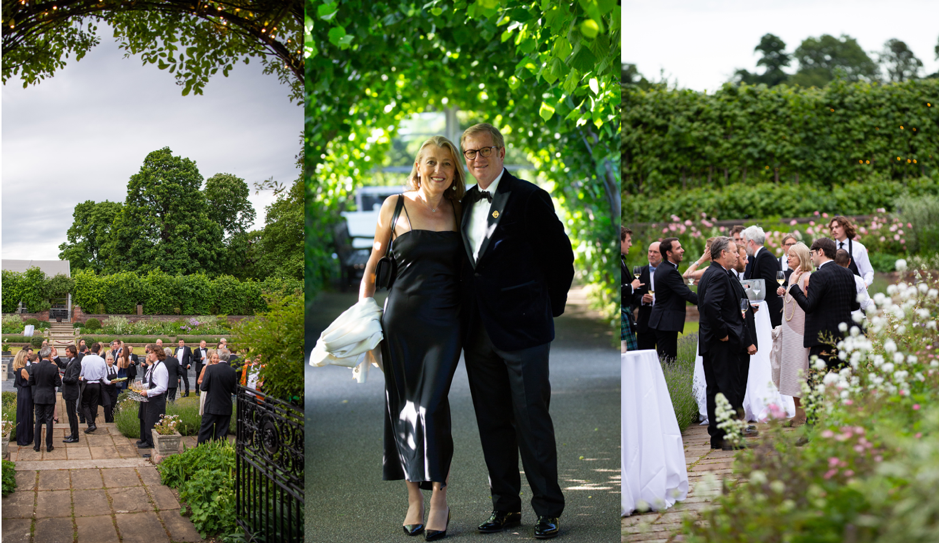 Reception in the Sunken Garden: Entering the garden (left), Virginie and Emmanuel Cruse (middle), guests enjoying 2014 Bollinger La Grande Année (right)
Reception in the Sunken Garden: Entering the garden (left), Virginie and Emmanuel Cruse (middle), guests enjoying 2014 Bollinger La Grande Année (right)
This was the third and largest of Château d’Issan’s series of banquets to celebrate the union, following an event at the Houses of Parliament in 2018 and Westminster Abbey in 2015. Emmanuel, his wife, Virginie, and Château d’Issan’s Commercial Director, Augustin Lacaille were delighted to return to London to host friends and associates in a market close to their hearts.
The reception took place in Kensington Palace’s newly-redesigned Sunken Garden (unveiled to the public for the first time in July 2021), where guests were served the 2014 vintage of Bollinger La Grande Année – a champagne to which Queen Elizabeth awarded a Royal Warrant in 1955. Following the call to dinner, guests joined a short private tour of the Palace’s State Apartments, with bespoke tour booklets leading them through its majestic halls. The banquet took place in the King’s Gallery, with Emmanuel situated below a wind-dial, which, hailing from 1694, still shows the direction of the wind to this day. Adorned on the face of the dial is Great Britain, enlarged to match up to its trusty neighbour, France.
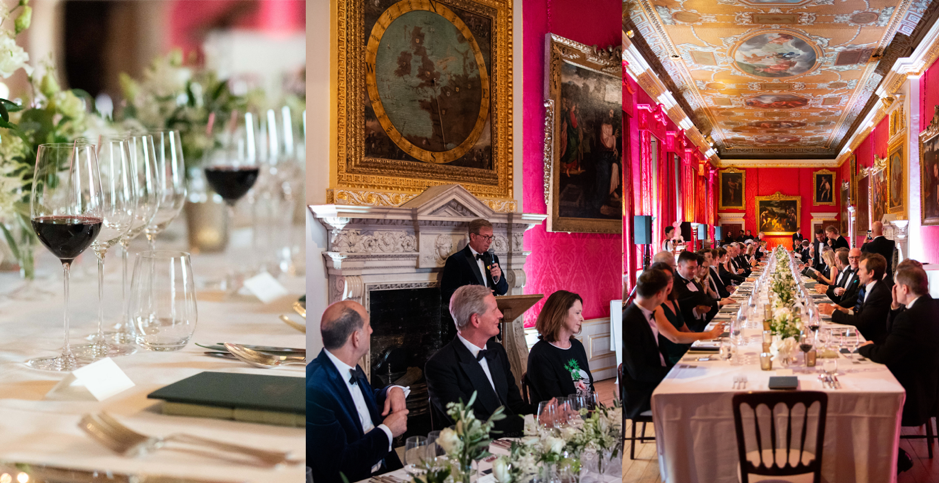 The Royal Banquet: The King’s Gallery table set (left), Emmanuel’s speech (middle), guests seated (right)
The Royal Banquet: The King’s Gallery table set (left), Emmanuel’s speech (middle), guests seated (right)
What is the connection between Eleanor of Aquitaine and Château d’Issan?
In his introductory speech, Emmanuel shared with his esteemed guests the role of Château d’Issan, formerly Lamothe-Cantenac, in consummating the marriage between Eleanor of Aquitaine and King Henry II – the former being an avid lover of Bordeaux wines. Bordeaux specialist, Jane Anson shared further historical insight into Eleanor of Aquitaine, explaining that “her contribution to England extended beyond her lifetime”, and “she continued to support the wine of Bordeaux” throughout her reign.
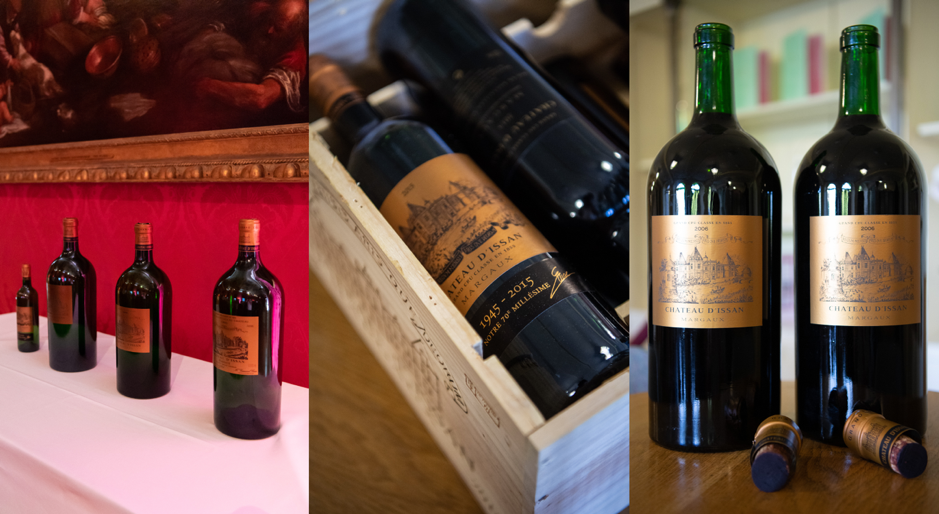 The wines: all formats displayed (left), Château d’Issan 2015 (middle), Château d’Issan 2006 in jeroboam (right)
The wines: all formats displayed (left), Château d’Issan 2015 (middle), Château d’Issan 2006 in jeroboam (right)
A bespoke menu booklet at each place setting documented Château d’Issan’s rich history, while the white flowers and green foliage adorning the centre of the table took inspiration from the flora and fauna found at the estate – as well as traditional wedding flowers.
Honing in on their union, themes of Bordeaux and Great Britain were integrated into the dinner menu: to start, guests were served Château d’Issan 2015 with a pigeon and bacon ballotine, foie gras ganache, and pear. Jeroboams of Château d’Issan 2010 were served alongside a baked cannon of lamb, confit shoulder, and potato crown. Château d’Issan 2006 was also served in jeroboam format alongside a Franco-British cheese course, comprising Comté, Mimolette, and Stilton. Finally, imperials of Château d’Issan 1995 were poured with a dessert of dark chocolate mousse, coconut sorbet, peanut, and lime.
For further information on WLPR’s tastings and events, please contact the team here.
While this year’s en primeur releases are yet to kick into full gear, the past week has seen key entries from the likes of Berliquet, Pontet-Canet, Palmer, Haut-Batailley, Lafleur, and more. Reporting on a shorter week of releases than usual due to the French bank holiday on Thursday 26th May, we examine the latest 2021s to market.
Released on Tuesday 24th May at £38.15 per bottle, Berliquet achieves its highest-ever combined score from Wine Lister partner critics, Antonio Galloni and Neal Martin (Vinous), who both award 91-93 points. While up on the last two years’ release prices, one top UK merchant has informed us that this is understandable at this stage in Berliquet’s progression, especially considering the comparable rise in quality and pricing from its Chanel siblings, Rauzan-Ségla and Canon.
This was followed shortly by Pontet-Canet 2021, which is so far being offered at around £74.17 per bottle. While slightly up on last year’s release price, it still poses as a good-value pick relative to its appellation, especially considering its status as the sixth-highest scoring Pauillac according to WL score (see here).
Also entering the market on Tuesday, Palmer’s 2021 vintage is another stand-out offering from the estate, reminding the Wine Lister team of a Palmer from the 1990s, but with more energy and ripeness. At £237 per bottle, the 2021 opens 1% below the 2020 release price, while volume released is down 30% this year. This, alongside strong critics’ scores and a propitious renovation programme currently underway, should no doubt encourage the success of the latest release.
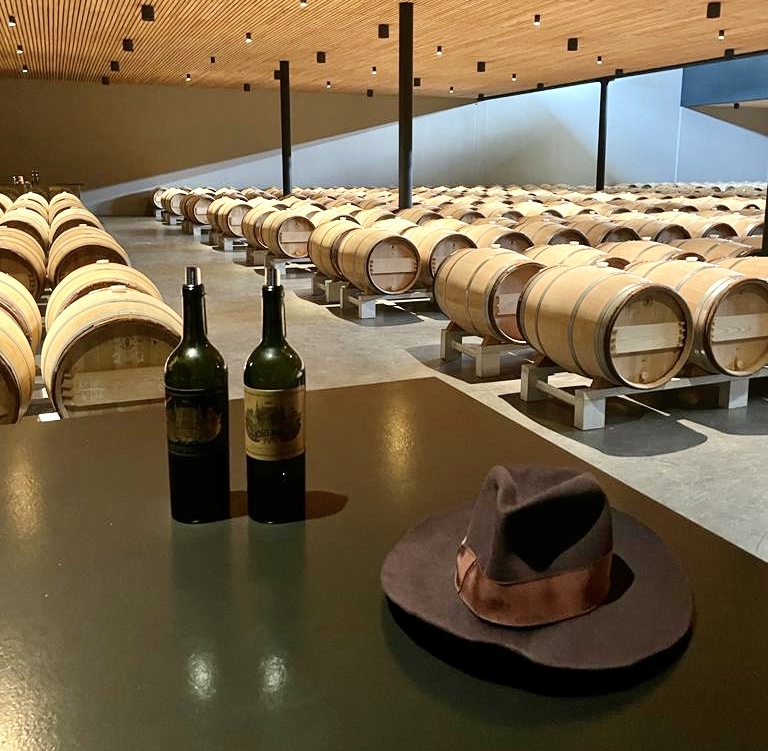 This week saw releases from Palmer – tasted by the Wine Lister team in the cellar
This week saw releases from Palmer – tasted by the Wine Lister team in the cellar
Released on Wednesday 25th May, Haut-Batailley 2021 is so far being offered at around £39 per bottle (slightly down on the 2020 release price). As with the other Cazes properties, mildew pressure has impacted the yields in 2021, and volume produced is down 10% compared to the 2020. Its sibling in Saint-Estèphe, Les Ormes de Pez 2021 followed suit, and is so far being offered at around £18 per bottle – also fractionally down on last year’s release.
Finishing the week with a bang, Lafleur 2021 was released on Friday 27th May through its UK agent, Justerini & Brooks at £542.33 per bottle. While entering the market 3% and 12% up on the 2020 and 2019 release prices respectively, there is no remaining availability of last year’s release on the market, and the 2019 has more than doubled in price since its release. As the second-best Quality performer of red Bordeaux in 2021 (after Cheval Blanc), and with a history of consistent and impressive price performance post-release, this will be one of the best buys of the campaign for those lucky enough to get their hands on it.
Also released during this period: Sociando-Mallet, Laroque, Alter Ego, Clos du Marquis, and Nénin.
The first Bordeaux 2021 en primeur releases have started to trickle through over the past two weeks, with key entries from Batailley, Carruades de Lafite, Duhart-Milon, Pavie, Cheval Blanc, Léoville Las Cases, Angélus, and the Barton family wines.
Kicking things off on Monday 9th May, Batailley 2021 was released at £27.50 per bottle (flat on the 2020 and 2019 release prices), setting a positive pricing tone in a year where reduced quantities had prompted apprehension. Indeed, the estate’s Managing Director, Frédéric Castèja informed Wine Lister that Batailley saw no mildew in 2021, and yields are therefore at a “normal” 50 hl/ha.
Released on Thursday 12th May at £165 per bottle, Carruades de Lafite 2021 similarly presents a discount on the 2020 and 2019 release prices, while entering the market below current prices of all recent back-vintages. The wine has shown to be one of the best price performers post-release in Wine Lister’s latest Bordeaux Study, with the 2020 already witnessing a 39% price increase over the past year. Carruades’ younger cousin, Duhart-Milon 2021 was also released on Thursday at £56 per bottle.
Another encouraging price move countering the early fears of the trade, Pavie 2021 was released on Wednesday 18th May at £232 per bottle – offering a discount of 3%-13% on all physical vintages back to 2015. Cheval Blanc 2021 was released on Thursday 19th May at a slight premium on the past two years’ release prices, though still below average prices of all back-vintages on the market up until 2014. With a quality that matches recent top vintages (2019, 2018, 2016, 2015), while priced at an average 28% below them, the 2021 has already seen successes. Indeed, one top UK merchant reports having sold “even more than last year”.

Cheval Blanc’s Technical Director, Pierre–Olivier Clouet, taking the Wine Lister team through the 2021s
A similarly successful entry (in the words of another top UK merchant), Léoville Las Cases 2021 was released on Friday 20th May at £162.50 per bottle – a significant 18% down on the 2020 release price. As well as offering the greatest discount from last year’s opening price seen of key releases thus far in the campaign, the 2021 receives a score of 94-96 from both Vinous’ Antonio Galloni and Neal Martin.
Upping the pace this week (on Monday 23rd May), we saw further releases from Angélus and the Barton family. The 2021 is the first vintage of Léoville Barton and Langoa Barton vinified in the Barton family’s new winery, and the last before the passing of the estates’ legendary owner, Anthony Barton. The vintage also marks 200 years of the family’s ownership of Langoa Barton, which will be commemorated with a special-edition label on the 2021, and the release of a limited-edition, multi-vintage case.
Also released during this period: Carillon d’Angélus, La Lagune, Petit Cheval, Cantemerle, L’Extravagant de Doisy-Daëne, Potensac.
Wine Lister’s real-time, wine-by-wine analysis of this year’s campaign is available in email newsletter form through a Pro+ subscription. For more information on this, please contact us.
Wine Lister’s COO, Chloe Ashton shares her thoughts on this year’s en primeur campaign so far.
The latest Bordeaux en primeur campaign is already underway, with Batailley 2021 opening the stage at the beginning of last week, and Domaines Baron de Rothschild’s Carruades and Duhart-Milon following suit. Cantemerle’s release on Friday 13th rounded out the week, and thus far starting prices have been a relatively pleasant surprise.
What does the trade expect from this year’s campaign?
In Part I of Wine Lister’s annual Bordeaux study, we asked key members of the global fine wine trade about their expectations ahead of the 2021 campaign. Of 47 respondents, half expected prices to be somewhat more expensive, or significantly more expensive than 2020 vintage releases, after rumblings on La Place of strong trading over the past few months.
 Bordeaux study (p.10): Founding members survey – 2021 release price expectations
Bordeaux study (p.10): Founding members survey – 2021 release price expectations
After the first physical en primeur week in Bordeaux since the 2018 vintage (our view of the vintage can be found here), the trade will at least have had the chance to work their way through a vintage so complex that tasting was surely a necessity. With such a heterogenous vintage, pricing strategies should logically also be extremely varied, making the potential successes of 2021 sales difficult to predict. Nonetheless, here’s what we know:
- Wine Lister’s annual Bordeaux study reveals that confidence in Bordeaux us up. Respondents increased ratings on last year for three quarters of the wines included in our study – after so many trade members have been reminded of the joys of tasting in situ, both these elements could contribute to campaign positivity and momentum, with merchants backing those properties they historically believe in, and/or were indeed impressed by during en primeur tastings
- 2021 appears to be a vintage that speaks from the soil, so imparting knowledge of the best terroirs to customers should help to create demand for the best-performing wines in general
- Outside of focusing only on the very best, 2021 may be a vintage for pleasant surprises – the fresher, lower-alcohol, and more classical style of wines certainly garner appeal from traditional palates, so any merchant or collector seeking this style of drinking experience in the near to mid future could do well in seeking out some of the better-value wines hailing from this complicated campaign
Wine Lister’s wine-by-wine analysis of this year’s campaign is available in email newsletter form through a Pro+ subscription. For more information on this, please contact us.
Wine Lister’s Founder and CEO, Ella Lister shares her thoughts on Bordeaux’s 2021 vintage.
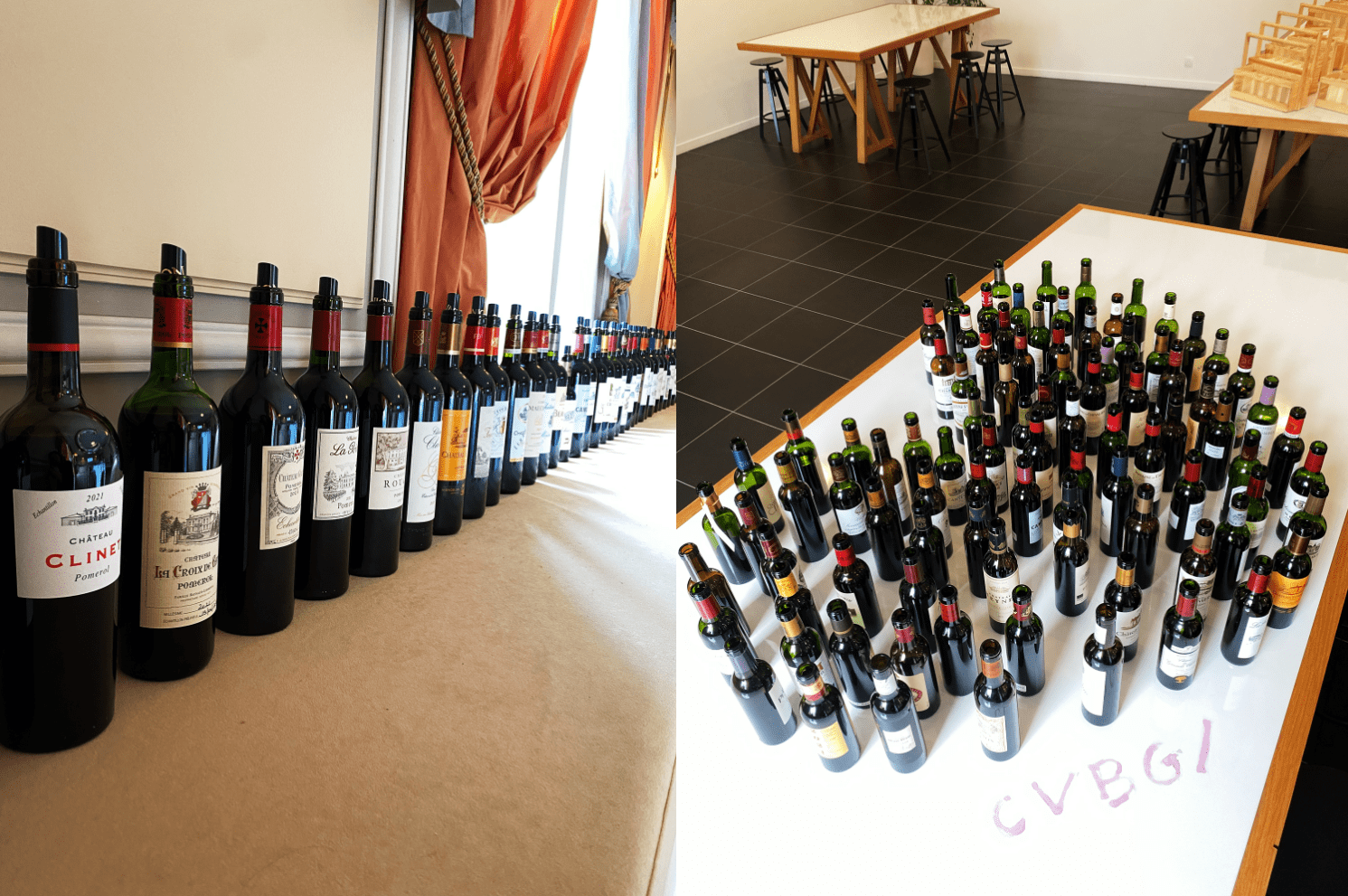 Bordeaux en primeur tastings: UGCB (left) and CVBG (right)
Bordeaux en primeur tastings: UGCB (left) and CVBG (right)
What can we expect from Bordeaux 2021?
The most complicated vintage since 2013, Bordeaux 2021 had everything thrown at it. The vines suffered a barrage of challenges during the growing season, from frost, then mildew, to a lack of the all-important hydric stress during a cool, cloudy summer. “It was a tiring vintage for us, and psychologically difficult” recalls Juliette Couderc, the new technical director at Château L’Evangile.
Bordeaux had been lucky with six relatively clement vintages in row, and en primeur tasters had been spoiled – especially with the trio of 2018, 2019, and 2020. Tasting more than 350 wines from the 2021 vintage in late April, we were reminded of en primeur tastings of old – the art of seeing through the wood, the hard tannins, the searing acidity, and attempting to form an idea of the wine’s future potential. And potential there is, if much less widespread than in the last three years. Buying decisions will need to be made carefully, and the critics’ views will be more important than in recent vintages blessed with high quality across the board.
Vinegrowing and winemaking have come on even in nine years, with know-how and tools at the disposal of producers that they didn’t necessarily have in 2013. Furthermore, 2021 had a saving grace – an unusually long growing season, beginning with early bud break, around the beginning of April, and ending with harvest dates running well into October, thanks to an Indian summer that finally provided some much-needed sunshine, with the sunniest October since 1991. Pierre-Olivier Clouet, technical director of Château Cheval Blanc, referred to a vintage “slow-cooked at a low temperature” following six years of cooking “on a high heat”.
The vintage was more challenging for merlot than for cabernet (franc or sauvignon), as the grape variety is more susceptible to mildew. Being an early ripener, merlot also missed out on the best of the Indian summer, whereas much cabernet benefitted from a warm and sunny early October, where vignerons dared to ignore the pessimistic weather forecasts for the weekend of 3rd and 4th October and hadn’t already rushed to pick before the non-existent rain. “The weather forecast was predicting an apocalypse,” recalls Vincent Millet, managing director of Château Calon-Ségur in Saint-Estèphe, but the cabernet grapes weren’t ready, so he waited, “and in the end there was no rain at all, and then a good stint of sunshine”. Further south in Margaux, Alexis Leven-Mentzelopoulos, co-owner of Château Margaux, echoes, “It was out of the question to pick unripe grapes ”.
At Château Ducru-Beaucaillou in Saint-Julien, owner Bruno Borie says the 2021 vintage is an “ode to cabernet sauvignon, which was much more resistant than merlot at every step.” However, cabernet’s upper hand in 2021 does not neatly translate into a left-bank vintage as might be expected. The right bank has its fair share of hits, and, bizarrely, fewer misses.
The watchword in 2021 is heterogeneous, and quality is undoubtedly very patchy in 2021, ranging from the seriously disappointing to the truly exceptional (though we are not in 100-point territory in this vintage). This makes it a hugely interesting en primeur campaign to taste, to sell, and to buy. It is a year where châteaux had a real opportunity to stand out from the pack, usually thanks to outstanding terroir and the application of significant resources – both financial and human. “It was viticulture seven days a week,” explains Jean-Emmanuel Danjoy, estates manager of the Château Mouton-Rothschild stable, who, like many others, underlined the vital importance of the team’s unstinting dedication. It was necessary to adapt tirelessly in the vineyard and in the winery; to accept that the fruit coming in at the end of the season wasn’t that of the three previous vintages, and be willing to throw out tried and tested recipes to make a different kind of wine, suited to the vintage. “We didn’t go looking for density that simply wasn’t there”, underlines Vincent Decup, technical director at Château Montrose in Saint-Estèphe. Down the road at Cos d’Estournel, Dominique Arangoïts points out “it’s an opportunity for wine lovers to really uncover the terroir, because the wines are stripped right back.”
The biggest challenges were to achieve a full enough body and to avoid vegetal (pyrazine) notes, without over-extracting hard, green tannins or being over-reliant on new wood, which the more delicate fruit couldn’t absorb. Many of the more successful properties used gentler extraction techniques than ever, and added a significant proportion of press wine to fill out the mid-palate. Chaptalisation was widely resorted to for the first time since 2013. The 2021 vintage nonetheless offers refreshingly modest alcohol levels – around 13% rather than the 15% or 15.5% which had become ubiquitous in recent years – potentially a key selling point with consumers.
Generalisations are not easy (or wise) in a vintage of such disparity of quality and style, but with few exceptions, the red wines tend to come in a lighter, fresher vein, recalling the classical clarets of the 1980s and 1990s. “It’s a wine style from the 80s, but with ripe grapes,” muses Aymeric de Gironde, president of Château Troplong-Mondot. The fruit is more red than black, with lots of raspberry and even some rhubarb. The vintage is less opulently floral than the last three, and floral notes are more often on a slightly more vegetal spectrum – iris, violet and lily. The worst wines have hollow mid-palates and searing acidity, and often an overdose of oak. The very best are so pure and soothing that you would never imagine the sweat and tears that went into making them. For Olivier Gautrat, maître de chai at Château L’Eglise Clinet, it was “a difficult and exhausting vintage. We’ve been out of the habit of less explosive flavour in the grapes, so we were really scared, but the more we taste, the more we find real charm in the 2021s. ”
The dry whites are pure and fresh, and the best have a sumptuous complexity. The sweet whites are remarkable, but produced in tiny quantities, if at all. For this reason Christian Seely describes Château Suduiraut 2021 as “tragically beautiful”, with yields of less than 1 hl/ha. What the reds, whites, and sweet wines all share is high acidity, which will likely result in long ageing capacity. We look forward to tasting the wines again in bottle in a couple of years to confirm that!
350+ tasting notes will be published (in French) at Le Figaro Vin next week. In the meantime, watch this space for part II of this blog series, with a focus on the Bordeaux market, to be published next week. To track the impending Bordeaux en primeur releases, click here to discover our en primeur page.
In anticipation of this year’s en primeur releases, Wine Lister has published Part 1 of its annual in-depth Bordeaux Study. In collaboration with the world’s most visited wine website, Wine-Searcher, our market overview examines the region’s price performance and comparative popularity progression. Drawing upon valuable insight from 47 leading trade survey respondents, the study also identifies which properties have benefited from a rise in trade confidence over the past year, and explores recommendations for châteaux and merchants to see a successful 2021 en primeur campaign.
Please see our key findings below:
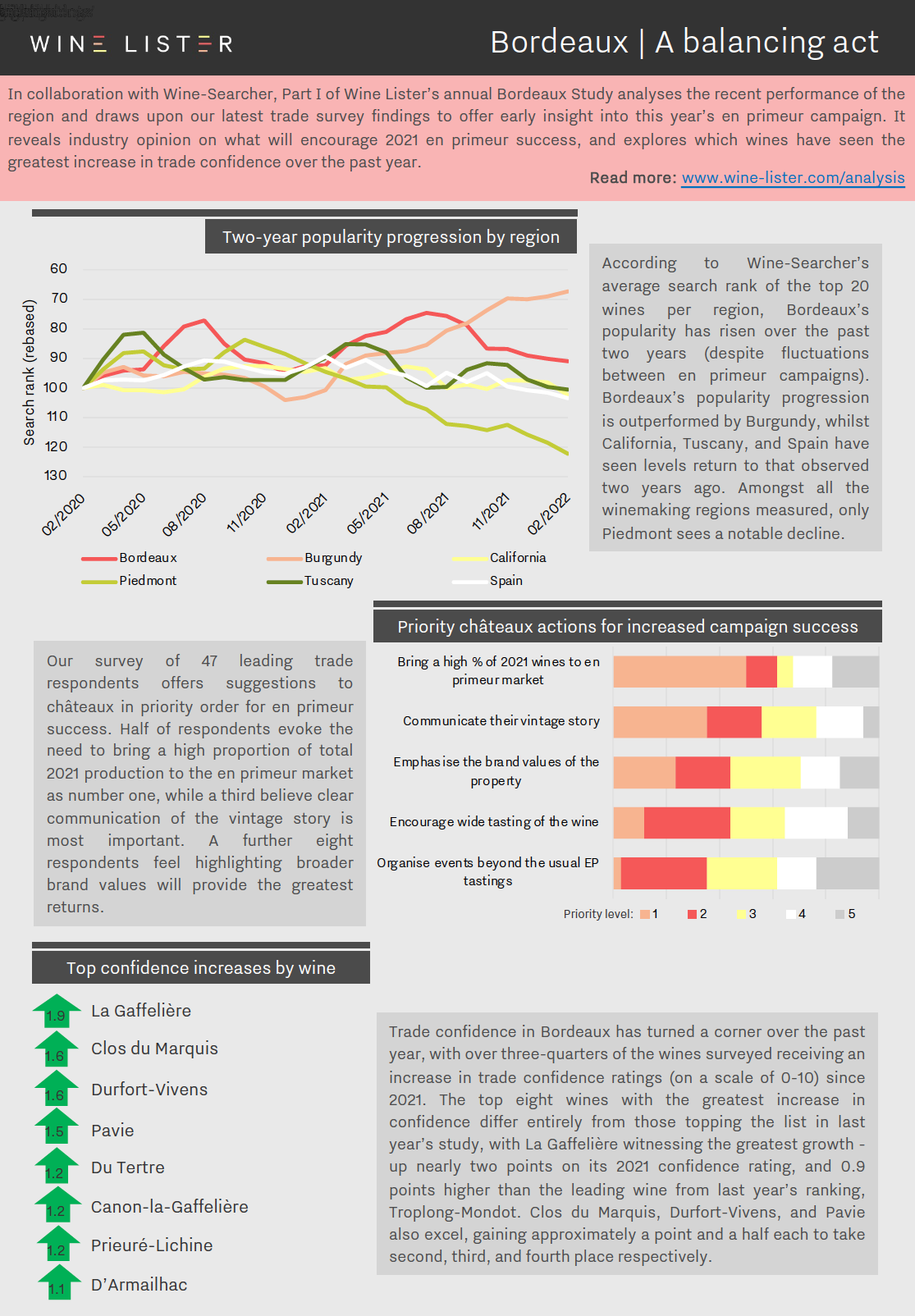
You can download the study digest here: Wine Lister 2022 Bordeaux Study – Digest. The full report can be purchased on our Analysis page, while Pro subscribers can access their free copy here. For further information on the data source, please see the Wine-Searcher website here.
A tour of the town with our Pessac-Léognan friends
The Larrivet Haut-Brion team joined Wine Lister to catch up with industry friends and meet some new faces in London’s fine wine scene after two years of restricted travel. Alongside a wine and cheese consumer tasting and a trade lunch, a series of individual merchant meetings provided the chance for the team to reunite with a market close to their hearts.
 Larrivet Haut-Brion in London: (from left) Brand Ambassador Clara Bouineau, Technical Director François Godichon, Managing Director Bruno Lemoine
Larrivet Haut-Brion in London: (from left) Brand Ambassador Clara Bouineau, Technical Director François Godichon, Managing Director Bruno Lemoine
What are the latest developments at Larrivet Haut-Brion?
The viticultural evolution at Larrivet Haut-Brion kick-started with the arrival of their Managing Director, Bruno Lemoine in 2007. Fascinated by the mosaic soil structure unique to the property (with top-soils composed in patterns of graves, colluviums, or sand and clay-limestone), Bruno conducted extensive terroir analysis which informed a detailed replanting programme, allowing the team to better match grape varieties to soil types for optimum quality. Among other changes, this led to an increased proportion of Cabernet Sauvignon and Cabernet Franc vines planted across the vineyard sites.
Further changes were implemented in 2015 with the arrival of Technical Director, François Godichon, who integrated several new production methods informed by his Burgundian roots. His parcel-led approach was reinforced in 2018 with the construction of a new cellar with space and facilities for a more precise vinification of individual micro-plots.
The final piece in Larrivet Haut-Brion’s winemaking puzzle, Cellar Master, Charlotte Mignon joined the team in 2020 and drives continuous experimentations with different ageing vessels, including combinations of concrete eggs, terracotta amphorae, and both new and old oak barrels. With Charlotte unavailable to join the visit (having just welcomed her second child), the London trio was completed by the property’s Brand Ambassador, Clara Bouineau, who joined the team in January 2022.
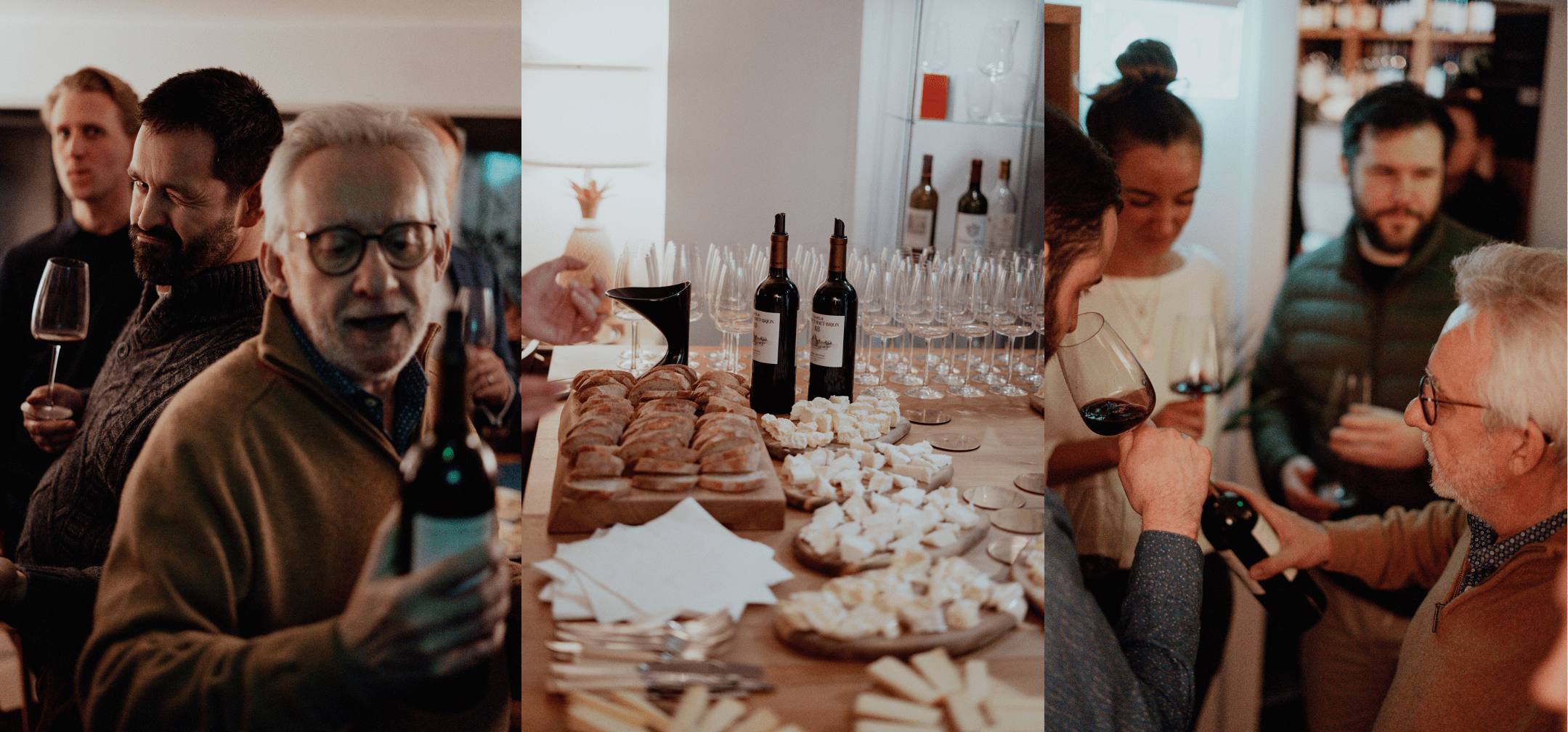 Wine and cheese tasting: Bruno and François tell guests about their wine (left), wine and cheese at Must & Lees (middle), Bruno pouring wine for guests (right)
Wine and cheese tasting: Bruno and François tell guests about their wine (left), wine and cheese at Must & Lees (middle), Bruno pouring wine for guests (right)
A marriage of Bordeaux wine with British cheese
The first stop on Larrivet Haut-Brion’s London tour was specialist wine shop Must & Lees, where the team was joined by some of North London’s Bordeaux enthusiasts for a wine and cheese evening on Wednesday 23rd February. Celebrating the estate’s commitment to the UK market, Wine Lister and Larrivet Haut-Brion devised a tasting format that showcased their red and white wines alongside a selection of 100% British cheeses from Neal’s Yard Dairy. While providing the opportunity for the team to build relationships with its consumers, the evening showcased the suitability of Larrivet Haut-Brion wines with some of the UK’s favourite fromages, including the likes of St Jude and Colston Bassett Stilton.
Wine and cheese pairing: Larrivet Haut-Brion Blanc 2017 with Sinodun Hill, Les Demoiselles Blanc 2019 with St Jude, Larrivet Haut-Brion Blanc 2014 with Baron Bigod, Larrivet Haut-Brion Blanc 2007 with Durrus, Les Demoiselles Rouge 2019 with Ogleshield, Larrivet Haut-Brion Rouge 2017 with Colston Bassett Stilton
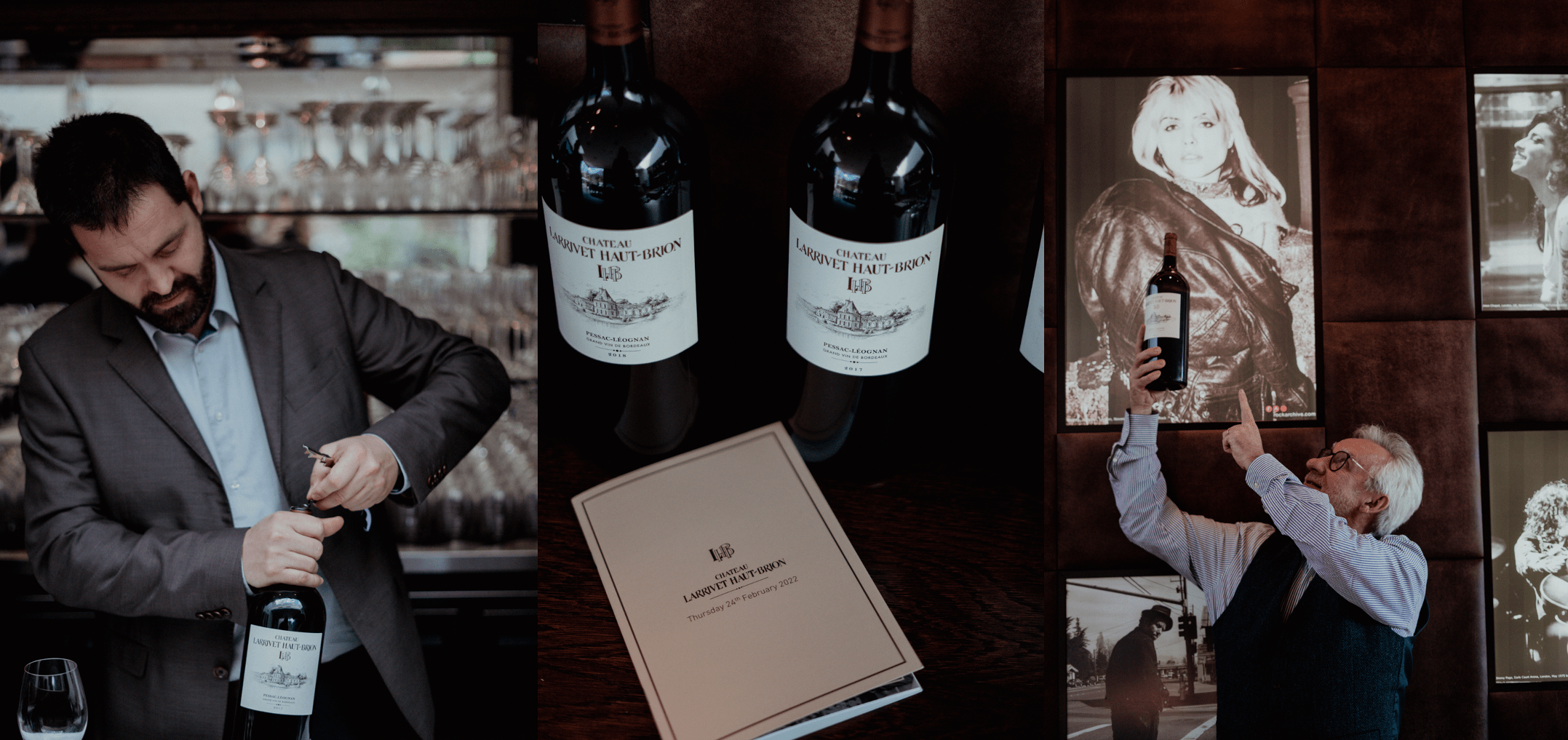 Frederick’s trade lunch: François opening a 2015 magnum (left), magnums on display with bespoke booklet (middle), Bruno presenting a magnum (right)
Frederick’s trade lunch: François opening a 2015 magnum (left), magnums on display with bespoke booklet (middle), Bruno presenting a magnum (right)
A taste for technical developments
Having already met with some of London’s key fine wine merchants, on Thursday 24th February, Wine Lister invited a handful of its fine wine trade and press friends for lunch at Frederick’s to discover some of Larrivet Haut-Brion’s best recent vintages in magnum.
With positive feedback across the board, Larrivet Haut-Brion’s whites showed freshness and complexity, thanks to the blending of Sauvignon Blanc with Sémillon from old vines grown on limestone soils. Alongside an impressive showing of some iconic recent vintages of reds (including 2005, 2010, 2015), the 2017 Rouge provided a promising picture of the future of Larrivet Haut-Brion 2021, with a low proportion of Merlot offset by a higher percentage of Cabernet Franc mirroring the projected blend of this year’s release – which may contain no Merlot at all.
To round off the lunch, the Larrivet Haut-Brion team poured some of their favourite wines from outside the property – an exercise that they believe is crucial to learn and gain inspiration from others. Amongst their “beyond Bordeaux” selection were Pierre Gerbais’ Prestige Extra Brut, Mas Jullien 2018, and Domaine Moingeon Saint-Aubin 1er Cru Sur Gamay 2018 – each giving guests a glimpse into the team’s personal preferences.
Wines tasted: Les Demoiselles Rouge 2019, Larrivet Haut-Brion Rouge 2019, Larrivet Haut-Brion Rouge 2018, Larrivet Haut-Brion Rouge 2017, Larrivet Haut-Brion Rouge 2016, Larrivet Haut-Brion Rouge 2015, Larrivet Haut-Brion Rouge 2010, Larrivet Haut-Brion Rouge 2005, Les Demoiselles Blanc 2020, Larrivet Haut-Brion Blanc 2020, Larrivet Haut-Brion Blanc 2019, Larrivet Haut-Brion Blanc 2018, Larrivet Haut-Brion Blanc 2011
For further information on WLPR’s tastings and events, please contact the team here.
Increased interest online across both banks
Wine Lister’s annual in-depth study shines a spotlight on the pattern of increased interest in some Bordeaux wines over the past two years, with key properties across appellations seeing elevated popularity during the pandemic.
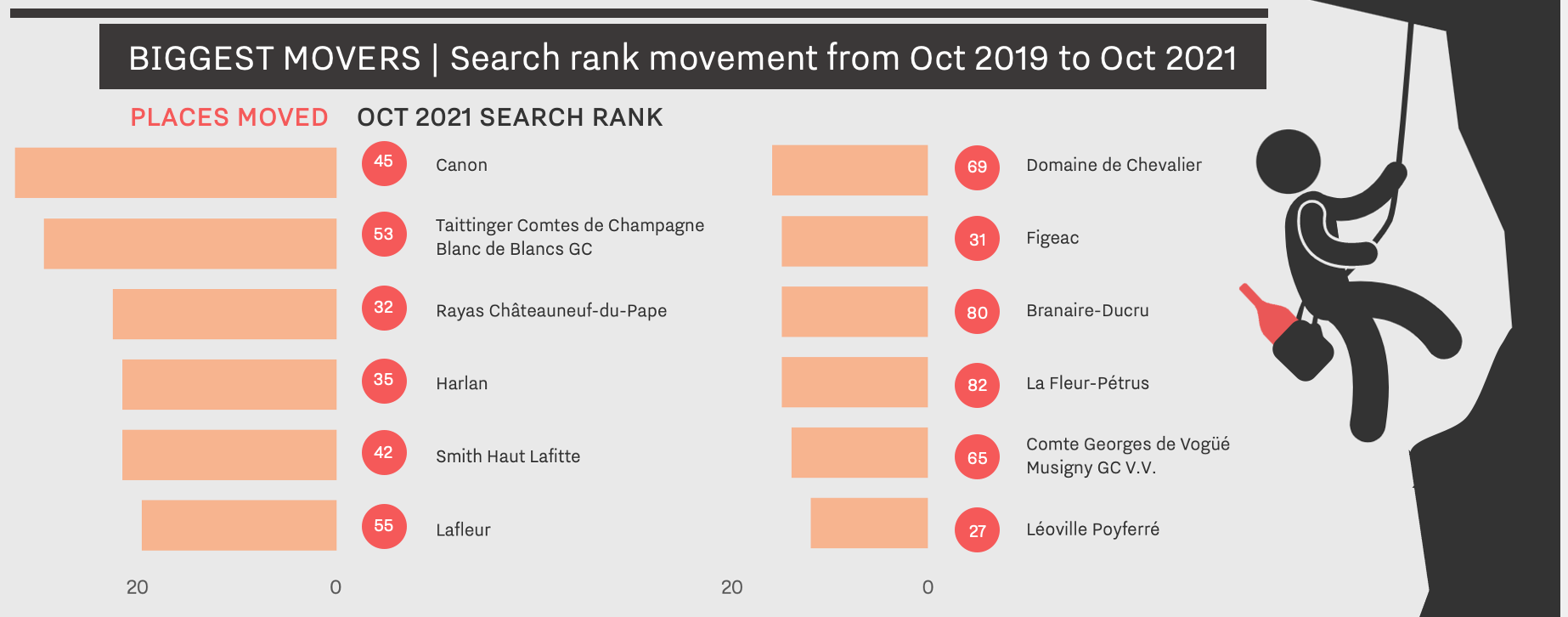 Wine Lister Leagues 2021: the Biggest Movers in search rank – Wine Lister’s measure of popularity (p.6)
Wine Lister Leagues 2021: the Biggest Movers in search rank – Wine Lister’s measure of popularity (p.6)
Using monthly search data from the most-visited wine website in the world, Wine-Searcher, Wine Lister’s Biggest Movers highlight wines whose online search rank has improved the most between October 2019 and October 2021 (within the top 100 most popular wines).
Which wines have seen the greatest increase in online popularity over the last two years?
The list of top 12 popularity movers comprises a range of price points, reflecting the broad spectrum of online fine wine enthusiasts, from cult classics to up-and-coming wines to watch. The findings indicate that appetite for Bordeaux has not waned, with increasing searches for Bordeaux bottles correlating to the success of the last two en primeur campaigns, within the context of a global pandemic.
Right Bank recognition
Rising 30 places, Canon was the biggest popularity mover, and takes first place in the League. Indeed, in February 2021, Wine Lister’s annual Founding Members Bordeaux survey revealed the trade’s opinion of Canon as having the most potential to see the greatest increase in demand in the near-to mid-term; naming Figeac a close second, which secures eighth position in this year’s Biggest Movers League.
Pomerol continues to prove popular – alongside Figeac, Lafleur has moved up 20 places, to sixth position in the League, while Jean-Pierre Moueix’s La Fleur-Pétrus is also featured, in 10th place.
Left Bank elevation
Two Pessac-Léognan properties appear in the top 12 Biggest Movers, with Smith Haut Lafitte and Domaine de Chevalier landing in fifth and seventh place respectively. Smith Haut Lafitte red 2020 received its highest score from Wine Lister partner critic, Antonio Galloni (for Vinous) of 95-97 points since the celebrated 2016 vintage – on release en primeur in June this year, it was announced that the bottles will sport special edition labels, marking owners’ Florence and Daniel Cathiard’s 30th harvest, and 655 years of the property.
Representing Saint-Julien, Léoville Poyferré and Branaire-Ducru have seen upward quality and popularity trajectories in recent years. With the latter boasting another 17-point score from Jancisrobinson.com for the 2020 vintage, the property continues to offer notable value for its quality.
Popular picks beyond Bordeaux
Harlan is the only non-French Biggest Mover this year, not least thanks to Will Harlan and his team’s conscientious efforts to maintain strong connections with the European fine wine trade. The only champagne to be featured in the League – Taittinger Comtes de Champagne Blanc de Blanc – has a strong reputation within the industry as one of the most tradeable Grandes Marques, with investment appeal encouraging its search rank to increase by 30 places in the past two years. The wine has gained further attention from the collector market following the postponed release of the landmark 2008 vintage, in October 2020.
A popular choice amongst the trade, Rayas’ Châteauneuf-du-Pape is cited in both Wine Lister’s articles on Drinking with experts: your favourite sommeliers’ favourite wines and Drinking with experts: your favourite winemakers’ favourite wines, and jumps an impressive 23 places in search rank, while collector’s favourite, Comte Georges de Vogüé Musigny climbs 14 places, to 11th in the League.
For the full analysis, download your free copy of Wine Lister’s 2021 Leagues here.
The insider’s guide to fine wine trends, and the most compelling wines to watch
Wine Lister has released its second annual Wine Leagues, celebrating some of the top-performing wines and producers in today’s new and much-diversified fine wine era. Informed by an in-depth trade survey with leading industry figures, the report provides a 360° view of those regions, producers, and wines that have seen strides in quality, popularity, economic promise, and more in 2021.
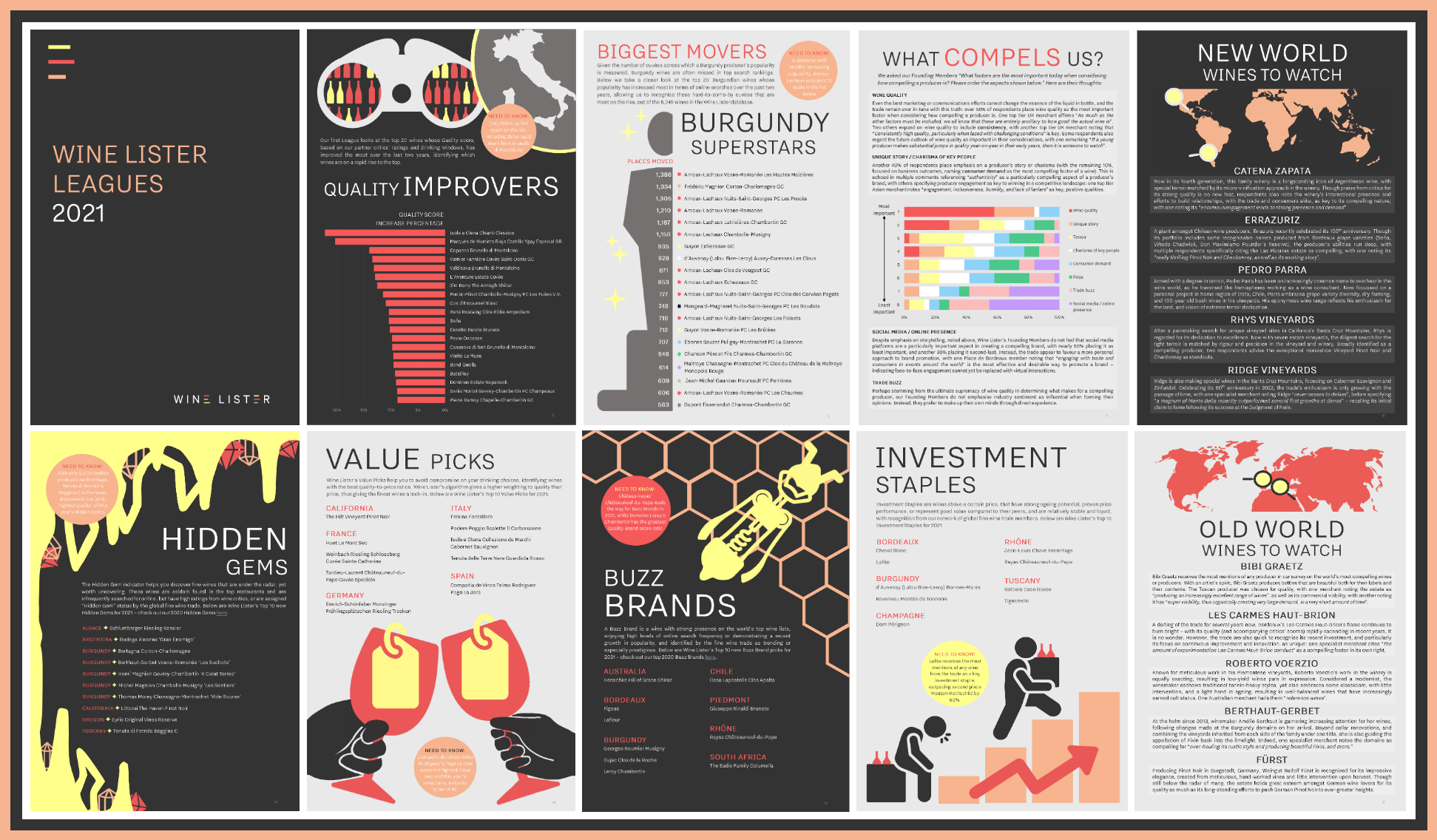
Wine Lister’s annual in-depth survey sees our expert panel of 47 CEOs, MDs, and wine department heads share their insight on some of the fine wines to have on your radar, as we ask them:
“What are the most compelling wines and producers in the market today?”
Respondents singled out 188 wines and producers collectively, that span no less than 20 major regions. Within the list, our team identifies Bibi Graetz, Les Carmes Haut-Brion, Roberto Voerzio, Berthaut-Gerbet, and Fürst as wines to watch in the Old World, whilst calling out the New World wonders of Catena Zapata, Errazuriz, Pedro Parra, Rhys Vineyards, and Ridge Vineyards.
The report also includes rankings across:
- Biggest quality improvers, which show impressive movement from Italy (occupying five places in the list of the top 20 by Quality score progression), with Isole e Olena Chianti Classico leading the pack
- Best search rank movers, wherein Bordeaux represents eight of the top 20 wines whose popularity has increased most in terms of online searches (including Smith Haut Lafitte, Domaine de Chevalier, Figeac, and Léoville Poyferré)
- Burgundy superstars, focusing on popularity movements from the trade’s darling region – Arnoux-Lachaux features 10 times in the list of top 20 Burgundian wines whose online searches have increased the most over the last two years
- Wine Lister’s top-10 recommendations per Wine Lister Indicator; Hidden Gems, Value Picks, Buzz Brands, and Investment Staples in 2021
For the full analysis, download your free copy of Wine Lister’s 2021 Leagues here.












 Wine Lister Leagues 2021: the Biggest Movers in search rank – Wine Lister’s measure of popularity (
Wine Lister Leagues 2021: the Biggest Movers in search rank – Wine Lister’s measure of popularity (